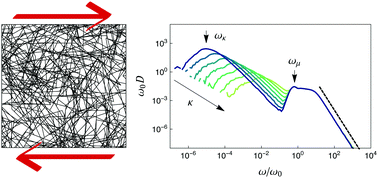Moduli and modes in the Mikado model
Abstract
We determine how low frequency vibrational modes control the elastic shear modulus of Mikado networks, a minimal mechanical model for semi-flexible fiber networks. From prior work it is known that when the fiber bending modulus is sufficiently small, (i) the shear modulus of 2D Mikado networks scales as a power law in the fiber line density, G ∼ ρα+1, and (ii) the networks also possess an anomalous abundance of soft (low-frequency) vibrational modes with a characteristic frequency ωκ ∼ ρβ/2. While it has been suggested that α and β are identical, the preponderance of evidence indicates that α is larger than theoretical predictions for β. We resolve this inconsistency by measuring the vibrational density of states in Mikado networks for the first time. Supported by these results, we then demonstrate analytically that α = β + 1. In so doing, we uncover new insights into the coupling between soft modes and shear, as well as the origin of the crossover from bending- to stretching-dominated response.

- This article is part of the themed collection: Force transmission by nonlinear biomaterials


 Please wait while we load your content...
Please wait while we load your content...